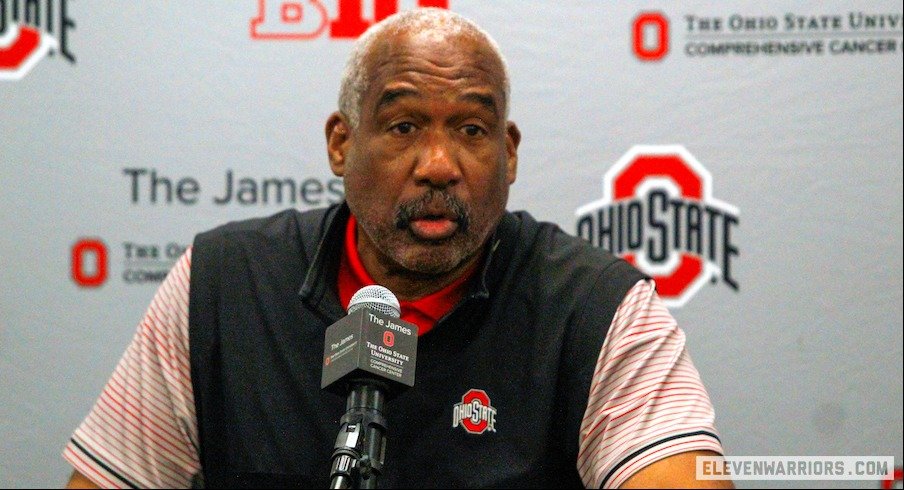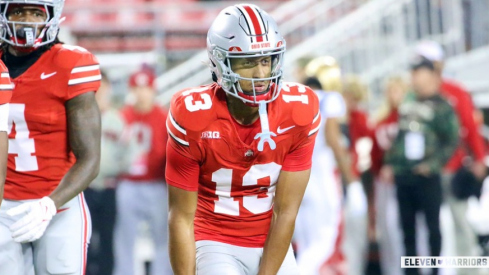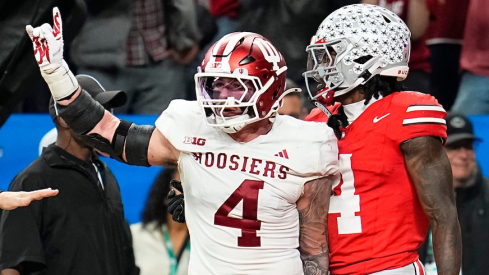If it was up to Ohio State athletic director Gene Smith, the NCAA would have put guardrails in place before it ever allowed athletes to begin profiting from their name, image and likeness.
Smith was the co-chair of an NCAA working group, along with Big East commissioner Val Ackerman, that spent nearly two years putting together proposed legislation for the NCAA to govern name, image and likeness. The NCAA ultimately never adopted that legislative proposal, however, instead opting to allow NIL benefits without any formal regulations due to concerns that the NCAA would face lawsuits if it attempted to restrict NIL deals.
That created an environment Smith often calls “the wild, wild west,” in which boosters have used NIL deals as inducements for recruits to attend specific schools. Smith always expected that would be an issue, though even he was not anticipating the national rise of NIL collectives, through which boosters have pooled their money together to make deals with athletes and recruits at specific schools.
“When we realized that we would not have enforcement, we saw the booster part (coming). I didn't see like collectives emerging where people would pool money together. No one saw that,” Smith told Eleven Warriors on Tuesday. “But we anticipated that if we didn't have enforcement that there would be problems. And when we voted it in and we saw that there wouldn't be any enforcement, we knew that there would be problems. So I'm not surprised that we're here in the inducement issues, but no one saw the collectives emerging. That’s totally new.”
Even so, Smith believes the NCAA could have kept boosters from blatantly using NIL as a recruiting inducement if it had put restrictions in place from the beginning.
“There's no question in my mind,” Smith said. “If we had passed the guardrails that we had recommended originally, and we allowed enforcement to enforce those guardrails, we wouldn't be where we are today. It's not to say that we can’t correct what has happened, and hopefully we can. But in my view, we should have put those guardrails in place last year, we should have moved for enforcement to enforce those guardrails.”
More than 10 months after athletes were first allowed to begin profiting from their name, image and likeness, the NCAA finally moved to begin investigating recruiting violations tied to NIL on Monday, when the NCAA issued guidelines specifying that boosters are not allowed to make NIL deals with recruits or even talk to them about NIL. Smith was a part of the working group that put together those guidelines, too, and he felt it was necessary for the NCAA to begin taking action in order to protect the present and future of college sports.
Smith and his colleagues around the NCAA still expect the NCAA to face lawsuits as they begin enforcing the new NIL guidelines, but unlike a year ago, the Division I Board of Directors decided putting rules in place and actually enforcing them is now worth the risk of any lawsuits that might attempt to stop the NCAA from doing so.
“We decided from a business point of view that we needed to do this,” Smith said. “Otherwise, we're going to have continued chaos in a wild, wild west environment. And we take the risk with any potential litigation. So we felt that this was a calculated risk and it was the right one to take for the health of what we do.”
Now that NIL deals with recruits have gone unchecked for 10 months, can the NCAA actually get the metaphorical toothpaste back in the tube and exercise control over what boosters and the schools they support can and cannot do? Smith admits he doesn’t know the answer to that question, but he thinks the NCAA has to try.
“You just don't know what you don't know,” Smith said. “The part that’s so challenging is the devil’s in the details, and then you don't know the details until you begin to investigate and see what's really true. Because there's some things out there that aren't true. But there's some things that, when you peel back the onion, you're gonna find some things. So I just don’t know at this point.”
“We felt that this was a calculated risk and it was the right one to take for the health of what we do.”– Gene Smith on the NCAA’s new NIL guidelines
Smith believes the guidelines that were passed Monday will be only the first step of the NCAA’s efforts to regulate NIL, as he says the working group that put together those guidelines has been asked “to continue to monitor this space and make recommendations around anything else we see emerge.”
“I think it's just the beginning of things that will pop up,” Smith said. “But it is a good beginning. Primarily because we’re reinforcing some do's and don'ts. And we're activating enforcement. That's the biggest thing for me and what was approved (Monday).”
As for Ohio State specifically, Smith doesn’t expect the new guidelines to have much impact on OSU and the NIL collectives supporting Ohio State athletes because OSU had already instructed those collectives not to make deals with recruits. From the beginning, Smith has wanted Ohio State’s focus to be on helping its current athletes benefit from NIL, which he thinks will ultimately help Ohio State in recruiting without any recruiting inducements being necessary.
“I asked our team to make sure we focus 100% on our current student-athletes. And so when recruits come to us, they see what our student-athletes are doing,” Smith said. “So helping our current kids take advantage of NIL the right way, and getting our environment, really everybody getting comfortable. People and corporations and everybody should feel comfortable doing this with our student-athletes. It's okay. And that's part of our challenge is getting everybody to embrace it.”
Although he doesn’t think the recruiting inducements that have been associated with NIL are a good thing for college sports, Smith is still glad athletes are able to profit from their name, image and likeness, which he thinks has been a “huge” net positive for college athletes.
“A number of our student-athletes are doing exceptionally well. They're learning a lot. We have more questions around taxes in April than I ever thought we’d get, because you gotta pay taxes,” Smith said. “So I just think it's a great educational tool. I think it's a great opportunity, particularly for those who have financial need, be it helping your family or be it the fact that they're on partial scholarship, and now they're mitigating potential debt that they may graduate with. So I think it's working. What we have to do is kill this inducement space in the recruiting area, those issues around that, but at the end of the day, it’s working.”


